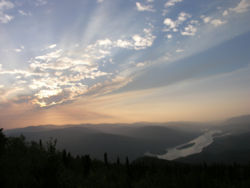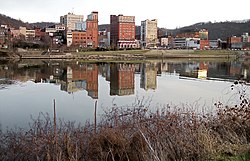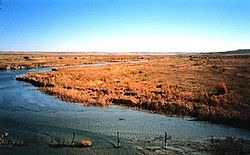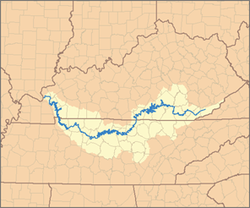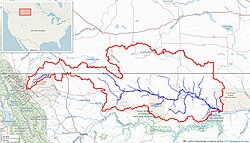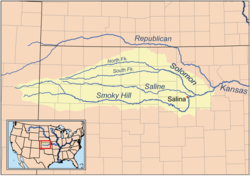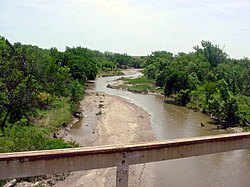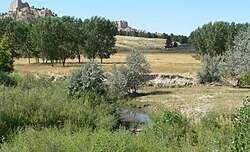Top Qs
Timeline
Chat
Perspective
List of longest rivers of the United States
From Wikipedia, the free encyclopedia
Remove ads
Remove ads
The longest rivers of the United States include 38 that have main stems of at least 500 miles (800 km) long. The main stem is "the primary downstream segment of a river, as contrasted to its tributaries".[1] The United States Geological Survey (USGS) defines a main-stem segment by listing coordinates for its two end points, called the source and the mouth. Some well-known rivers like the Atchafalaya,[2] Willamette,[3] and Susquehanna[4] are not included in this list because their main stems are shorter than 500 miles.

Seven rivers in this list cross or form international boundaries. Three—the Milk River, the Red River of the North, and the Saint Lawrence River—begin in the United States and flow into Canada; two do the opposite (Yukon and Columbia). Also a segment of the Saint Lawrence River forms the international border between part of the province of Ontario, Canada, and the U.S. state of New York. Of these seven rivers, only the Milk River crosses the international border twice, leaving and then re-entering the United States.[5] Two rivers, the Colorado and the Rio Grande, begin in the United States and flow into or form a border with Mexico.[5] In addition, the drainage basins of the Mississippi and Missouri rivers extend into Canada,[6][7] and the basin of the Gila River extends into Mexico.[8]
Sources report hydrological quantities with varied precision. Biologist and author Ruth Patrick, describing a table of high-discharge U.S. rivers, wrote that data on discharge, drainage area, and length varied widely among authors whose works she consulted. "It seems," she said, "that the wisest course is to regard data tables such as the present one as showing the general ranks of rivers, and not to place too much importance on minor (10–20%) differences in figures."[9]
Remove ads
Table
Summarize
Perspective
The primary source for watershed and discharge data in the table below is Rivers of North America. Conflicting data from other sources, if the difference is greater than 10 percent, is reported in the notes. Discharge refers to the flow at the mouth.[n 1] In the "States, provinces, and map" column, the superscripts "s" and "m" indicate "source" and "mouth". Non-U.S. states appear in italics. Except in the "States, provinces, and map" column, abbreviations are as follows: "km" for "kilometer", "mi" for "mile", "s" for "second", "m" for "meter", and "ft" for "foot".
Remove ads
Map

See also
Notes
- Rivers of North America says that of this total only about 170,000 mi2 (450,000 km2) of the basin contribute water to the river.[26] The University of Texas (UT) says, "The river collects rain, snowmelt and spring water from an area [of] about 215,338 mi2 [557,722 km2] including closed basins."[24] It says that 87,020 mi2 (225,380 km2) of the basin (about 48 percent), not counting closed basins, are in Mexico, while 93,821 mi2 (242,994 km2) (about 52 percent) are in the United States.[24] Kammerer cites a total basin size of 336,000 mi2 (870,000 km2).[16]
- The United Nations Environment Programme cites a total basin size of 246,000 mi2 (637,000 km2), split between 2,000 mi2 (5,200 km2) (about 1 percent) in Mexico and 244,000 mi2 (632,000 km2) (about 99 percent) in the United States.[28]
- Derived by subtracting the length of the East Fork Arkansas River of roughly 16 mi (26 km)[31] from Kammerer's total of 1,459 mi (2,348 km).[16]
- This is the combined length, 1,360 mi (2,190 km),[37] of the main stem, Prairie Dog Town Fork Red River, and Tierra Blanca Creek minus the lengths of the latter two, 160 mi (260 km)[38] and 75 mi (121 km).[39] Kammerer gives the length as 1,290 mi (2,080 km).[16]
- Also known as the Dakota River or Jim River and not to be confused with the James River of Virginia.
- This is the average discharge for the years 1982–94, derived by adding the discharge for each of these years and dividing by 13.
- According to the U.S. Army Corps of Engineers, a 115-mi (185 km) stretch of the river forms part of the U.S.–Canada border. This amounts to about 19 percent of the main-stem length.[91]
- Rivers of North America describes the discharge as less than 210 ft3/s (6 m3/s.
- This is the size of the basin upstream of a stream gauge near Kindred and at river mile 67.9 (river kilometer 109.3).[100]
- This is the average flow measured by a stream gauge near Kindred and at river mile 67.9 (river kilometer 109.3).[100]
- The main-stem length is calculated by subtracting the length of the Nabesna River from Kammerer's total of 659 mi (1,061 km).[16] The Nabesna River is roughly 75 mi (121 km) long, calculated by adding the 60 mi (97 km) from the Nabesna mouth to Camp Creek[101] to the distance, 15 mi (24 km), from Camp Creek to Nabesna Glacier,[102] Kammerer's most remote source for the Tanana.
- Reflects only that part of the basin above a stream gauge at river mile 43.3 (river kilometer 69.7) near Enterprise.[106]
- Measured by a stream gauge at river mile 43.3 (river kilometer 69.7) near Enterprise.[106]
- This is only a close approximation of the entire basin. It does not include a small fraction of the basin below the river gauge, located about 25 mi (40 km) upstream of the river mouth.
- This is the average discharge for the years 1990–2010, derived by adding the discharge for each of these years and dividing by 21.
- According to the Minnesota Department of Natural Resources, 394 mi (634 km) are in the United States. This amounts to about 72 percent of the main-stem length.[116]
Remove ads
References
Works cited
Wikiwand - on
Seamless Wikipedia browsing. On steroids.
Remove ads






